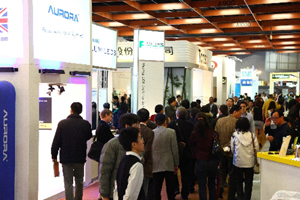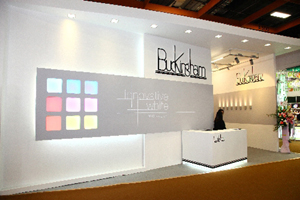MICE Opportunities for the LED Lighting Industry
2011/01/10 | By Michelle HsuLED lights the way for meetings and conventions

The MICE (Meetings, Incentives, Conferences, and Exhibitions) industry has grown rapidly in Asia over the past few years. The growth has been especially notable following the global financial crisis when hard-hit financial and manufacturing industries have not yet fully recovered, leading entrepreneurs to seek opportunities in other sectors, like the MICE industry.
MICE is a very large and inclusive industry, covering everything from individual company meetings lasting two or three hours to international events, such as trade shows, that stretch seven to 10 days. Even the 2010 Shanghai World Expo and the 2010 Taipei International Flora Expo, lasting up to six months, could be considered as super-large MICE activities.
Taiwan began developing its MICE industry in the 1970s, with annual international trade shows for a variety of export-oriented industries such as lighting, furniture, gifts, toys, hardware, and machinery. With the enthusiastic support and participation of foreign buyers, these trade shows grew rapidly and created lucrative opportunities for the growth of Taiwan's MICE industry. A number of pioneering MICE organizers were established on the island at that time and grew along with the industry.
The popular Taiwan Pavilion at the Shanghai World Expo was, in some ways, a good example of the island's strength in the MICE sector. The innovative application of LED lighting was seen as the key to the pavilion's success; it is also considered a unique advantage for Taiwan's MICE industry, at least in the Asian area.
New Creativity
MICE organizers use LED lighting as a new source of creative design. James Liang, general manager of Hwalin Design, has been engaged in stage and exhibition booth design for over two decades and has become a pillar of the industry in Taiwan. In his eyes, MICE is an industry with a huge demand for creativity. “We work for the same events every year, but have to make the same event look different every time,” said Liang, who feels a growing pressure to be creative from the many talented newcomers who have joined the LED lighting sector in recent years.
Fortunately, “LED lighting creates a new niche of competitive creativity for designers,” commented Liang, who is confident that his company can meet and overcome the competition. “LED lighting has a soft and delicate appearance, very suitable for generating an elegant and gracious ambiance in a public area.” In addition, LED is a green lighting source with high energy efficiency and low temperature, and is becoming the preferred choice of lighting for large exhibitions which traditionally used a huge amount of energy for illumination and air conditioning.
“LED lighting adds to the growth momentum of the MICE industry, and it provides a strong advantage for Taiwan's MICE companies in their competition with foreign rivals on the international market,” observed Liang, whose company has set up several branch offices in China as its first step into the largest MICE market in Asia.
Cultural Content
Uniplan Taiwan is a subsidiary of the Uniplan Group, which was founded in Germany in the early 1960s. Uniplan operates globally and set up its initial Taiwan branch, the predecessor of Uniplan Taiwan, in 1982, at a time when the island's MICE industry was ready to take off on the foundation that had been built in the previous decade. As a multinational corporation which frequently handles cross-border businesses, Uniplan deals with a multitude of cultural difference in different countries.

“If well applied, modern technology can present new dimensions of a country's cultural and traditional arts,” commented Katherine Tu, director of Uniplan Taiwan. In her eyes there is no conflict between modern technology and traditional culture; in fact, she believes they actually complement each other. This complementary nature was demonstrated at the Shanghai World Expo, where numerous countries used modern LED lighting to enhance their cultural performances—for instance, Brunei's wedding custom show, Saudi Arabia's traditional folk dances, Turkey's jazz and fashion show, Argentina's Tango Dance, and France's Alps light show.
YAOX5D Corp., the major architect of the expo's Taiwan Pavilion, won widespread recognition and acclaim for its creative design. The company was originally founded as an animation firm; with guidance from the government, it was transformed into a comprehensive MICE service company backed by strong capabilities in the computer and animation fields. The Taiwanese culture videos shown at the Taiwan Pavilion during fair were mostly designed and produced by YAOX5D. “The Taiwan Pavilion was a good example of the successful integration of Taiwan's IT strength and LED lighting innovation,” said Jill Wu, president of the company.
Success in the expo has brought considerable new business to YAOX5D. “Many companies and institutions, mostly in China, have contacted us for cooperation in MICE activities that they are planning to hold in the future,” reported Wu, who is very optimistic about the market potential of China's MICE industry in the near future. “Indeed, many companies around the world have seen the great market potential in China and have taken actions to secure a share of the market there.” She believes that Taiwan's cultural affinity with China gives it a distinct advantage against its foreign rivals there.
LED lighting is also being used with striking effect at the 2010 Taipei International Flora Expo, which opened on November 6, 2010. According to Ting Hsi-yung, director of the expo's organizing committee, more than 30 million natural flowers are on display in addition to hundreds of artificial LED flowers in the Pavilion of Dreams, which is sponsored by the Industrial Technology Research Institute (ITRI), Asus Computer, Delta Electronics, and Optoma Taiwan, among others.
The 438 pieces of “Florabot” in the pavilion are a kind of floral display that combines LED lighting with high-tech devices to present a “dance” in time with music and a “shake” in reaction to the movements of visitors. A similar combination of technologies will be used to make other electronic devices that can be applied in the daily lives of consumers.
Meanwhile, the Lite-On Group, one of the pioneers of Taiwan's LED industry, launched a new LED lighting product with a rich Taiwanese cultural content in 2010. The innovative product will be used in religious rituals during the annual Ghost Festival in mid-summer, replacing the candles and paper products that are traditionally burned at the time. As an eco-friendly alternative to the massive traditional waste, the religious LED lighting is expected to have much market potential in the future.
Growth Potential
The MICE and LED industries are actually intimately related in a complementary way; MICE creates profit opportunities for LEDs, and LEDs bolster MICE in its pursuit of further growth. This synergy is important, especially now. “MICE can not only help stimulate the growth of the international trade, shipping, financial services, and travel industries,” commented Jeremy M.C. Horng, director of the Exhibition Department of the Taiwan External Trade Development Council (TAITRA), which organizes a large number of major international trade shows, “it can also bring considerable business opportunities to related service industries and boost national economic growth.” In Taiwan, Horng added, the service industry accounts for around 70% of GDP, and has become the major driving force in economic growth.
“With creativity as its core value, the booming MICE industry will also help boost the creative/cultural industry,” said Thomas Tsou, secretary general of the Taiwan
Convention & Exhibition Association (TCEA). The recent enthusiasm of cities for hosting jumbo MICE events to carry out “city promotion” as part of their promotional packages—for example, Kaohsiung's holding of the 2008 World Games, Shanghai's organizing of the 2010 World Expo, and Taipei's hosting of the 2010 International Flora Expo—further expands the business range of the MICE industry.




